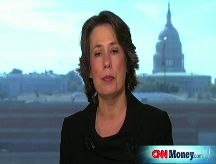Rescue plan: What's in it
Here's a breakdown of the major elements in the federal effort to restore confidence in the financial system.
NEW YORK (CNNMoney.com) -- The federal government on Tuesday announced a historic plan to restore confidence in the U.S. financial system and to spur banks to begin lending again more normally - both to each other and to consumers and businesses.
Here are the key elements that will be put in place first:
The Treasury will buy up to $250 billion in senior preferred shares in a wide variety of banks.
Nine of the largest banks have agreed to be the first institutions in which the government takes a stake. But the program will be available potentially to thousands of banks.
The government may take senior preferred shares up to the lesser of $25 billion or 3% of the bank's risk-weighted assets.
The stakes will come largely in the form of non-voting shares and may be sold to a third-party if the government wishes.
The shares will pay 5% a year in dividends for the first five years and 9% after that. The increase in the dividend may serve as incentive for the banks - if they have the private capital to do it - to buy back the government's shares before the five years are up.
The government will also receive warrants to buy additional shares worth up to 15% of the preferred stock it buys. The strike price for Uncle Sam: the average price the stock was selling for over the 20-day period preceding the government's purchase of preferred shares.
Given the battering bank shares have taken in the past week, if the government exercises its warrants soon, it is likely to make a profit from its investment in the first nine banks in the program, said Jaret Seiberg, financial services analyst at The Stanford Group, a policy research firm.
Participants in the program will be subject to the restrictions on executive compensation that Congress included in the financial rescue law that it passed on Oct. 3. One such measure, for example, requires that any bonus or incentive paid to a senior executive officer for targets met will have to be repaid if it's later proven that earnings or profit statements were inaccurate.
The Federal Deposit Insurance Corp. will guarantee new, senior unsecured debt issued by banks, thrifts and bank holding companies. The new debt that will be covered must mature within three years, and banks may opt in to this program until the end of June 2009.
The intent is to give confidence to the buyers of bank debt that they will get paid back no matter what.
The program will be paid for by user fees imposed on banks. No taxpayer dollars or dollars from the FDIC insurance fund will be used.
The FDIC will temporarily provide unlimited coverage for all non-interest-bearing accounts, which typically are those where businesses park money to cover their near-term expenses such as payroll. The increased coverage will last through the end of 2009.
The program will be paid for by user fees that are part of the premium the bank pays the FDIC to insure deposits. No taxpayer dollars or dollars from the FDIC insurance fund will be used.
The goal is to boost liquidity for otherwise healthy banks - particularly regional and local ones - that might otherwise have seen nervous depositors pull their money out in favor of putting them at larger institutions.
The Federal Reserve is finalizing plans for a temporary program in which it will buy high-quality three-month debt issued by businesses in the commercial paper market.
The commercial paper market, which has been sharply curtailed in recent weeks, is the prime source of funding used to cover operating costs at many of the nation's largest companies and financial institutions.
The program would begin on Oct. 27 and would remain in effect until April 30, 2009.
The intent of the program is to guarantee there will be a buyer of the debt, which in turn will make private-sector buyers more confident that they will get paid back if they, too, buy a company's short-term debt. That's because the company pays back debt holders by issuing new commercial paper.
When the government's rescue plan was first formally proposed little more than two weeks ago, the major initiative was supposed to be the purchase of troubled assets off of banks' balance sheets.
The rationale: Banks are having a hard time attracting capital because there is concern that they may be holding so-called "toxic" assets. Those assets have underlying value but no one has known how to price them in the wake of the housing crisis.
The four major steps the government announced on Tuesday do not preclude the Treasury from pursuing its asset-purchase option. Indeed, Treasury and White House officials have indicated they are still working on structuring a program to buy troubled assets, which the government could hold until the market recovers and then sell back to investors at a profit. But it clearly isn't going to be the first effort out of the gate.
CNN's Kelli Arena contributed reporting for the article. ![]()






